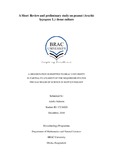| dc.contributor.advisor | Islam, Aparna | |
| dc.contributor.author | Nahreen, Ashfia | |
| dc.date.accessioned | 2019-10-29T04:07:03Z | |
| dc.date.available | 2019-10-29T04:07:03Z | |
| dc.date.copyright | 2018 | |
| dc.date.issued | 2018-12 | |
| dc.identifier.other | ID 17236020 | |
| dc.identifier.uri | http://hdl.handle.net/10361/12813 | |
| dc.description | This thesis is submitted in partial fulfillment of the requirements for the degree of Bachelor of Science in Biotechnology, 2018. | en_US |
| dc.description | Cataloged from PDF version of thesis. | |
| dc.description | Includes bibliographical references (pages 37-40). | |
| dc.description.abstract | Peanut (Arachis hypogaea L.) belongs to the family leguminosae and is one of the most important oil seed crops in the world. Peanut seeds contain high seed oil, proteins, amino acids and vitamin E. However, this crop faces several yield constraints like biotic and abiotic stresses. With the climate change, salt water intrusion to inland soil and loss of cultivable land makes it critical to develop a high yielding variety of peanut with salt tolerance. This can be achieved by utilizing biotechnology processes. A prerequisite for the establishment of a genetic transformation protocol is an efficient and reproducible protocol for the in vitro regeneration of peanut. For this, an extensive study of the existing in vitro regeneration protocols was performed. In light of these studies, the role and interaction of decapitated embryo explants in different combinations and concentrations of growth hormones of two farmer popular varieties was investigated. Among the various tested combinations of BAP and Kn in MS medium, the best combination was 3 mg/l BAP and 1 mg/l Kn for BINA Chinabadam 2 and 3 mg/l BAP and 0.5 mg/l Kn for BINA Chinabadam 4. Decapitated whole embryo proved to be a better explant than decapitated half embryo for both varieties. The highest percentage of shoot regenerating explants was seen in two days old decapitated whole embryo (90%) of BINA Chinabadam 2 and the highest average number of shoots was seen in two days old decapitated whole embryo of BINA Chinabadam 4 (5.10). Two days old explants also responded better in culture medium than old day old explants. | en_US |
| dc.description.statementofresponsibility | Ashfia Nahreen | |
| dc.format.extent | 40 pages | |
| dc.language.iso | en | en_US |
| dc.publisher | Brac University | en_US |
| dc.rights | Brac University theses are protected by copyright. They may be viewed from this source for any purpose, but reproduction or distribution in any format is prohibited without written permission. | |
| dc.subject | Peanut | en_US |
| dc.subject | Arachis hypogaea L. | en_US |
| dc.subject | BINA Chinabadam 2 | en_US |
| dc.subject | BINA Chinabadam 4 | en_US |
| dc.subject.lcsh | Plant tissue culture | |
| dc.title | A short review and preliminary study on peanut (Arachis hypogaea L.) tissue culture | en_US |
| dc.type | Thesis | en_US |
| dc.contributor.department | Department of Mathematics and Natural Sciences, Brac University | |
| dc.description.degree | B. Biotechnology | |

